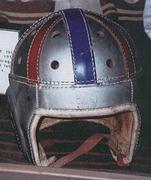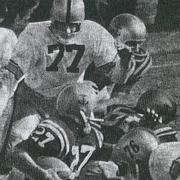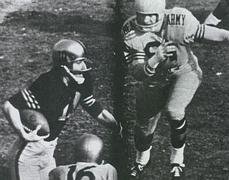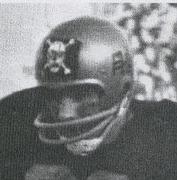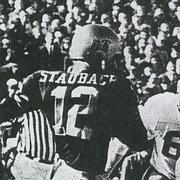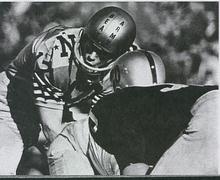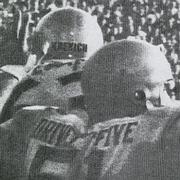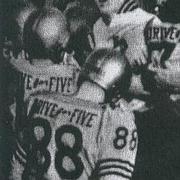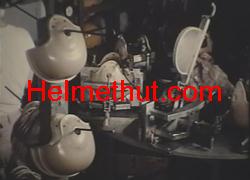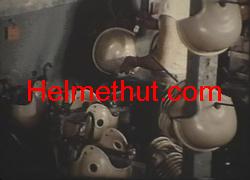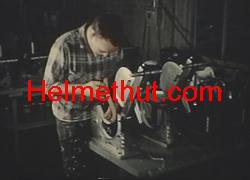Dear Dr. D.:
In the College All Star vs. the NFL Champions game at Soldier Field that
was played as summer camps were getting into full swing, did the College All
Stars wear their own helmets from their college teams, new pro teams, or from
the game itself and if the former, were they painted a uniform color/style for
the game. I just can't recall.
Thanks, Ken - BG .. RB.. DR
Dear Ken:
I give up on those initials -- all I can think of is bodyguard, running
back and doctor but that combo sounds impossible. Anyway, thanks for
remembering this interesting game -- it sure could get heated with the best of
the new kids challenging the veterans from the presiding NFL champion team
each summer. The College All Star's helmets along with the rest of their
uniforms were provided by the Chicago Tribune Charities who sponsored the
game. The All Stars used the Northwestern University facilities in Evanston,
Illinois as their practice headquarters and the game was played at Soldiers
Field (a sign of the times -- the lighting at Soldiers Field was so poor that
All Star games were only broadcast in black and white).
Longtime (and current) Northwestern equipment manager Bill Jarvis worked
the final All Star contest in 1976. Unfortunately the game ended prematurely
in the third quarter due to a severe lightning storm with the Steelers leading
24 - 0. Bill was picked to be the equipment manager for the All Star's because
of his similar position with Northwestern. He remembers fitting the players
with their choice of Riddell "TK-2," "Pac-3," or Wilson helmets. "A player
could also request any type of mask that he wanted" added Bill. "If he
requested a style that was not included in the equipment inventory provided by
the sponsors then we would borrow it from the Northwestern equipment
room." Bill recalled that the All Star helmets were white and he had to add
a single blue center stripe and three red stars on each side of the helmet.
There were also red player numerals located on the rear of the helmets. Bill
said that a player was allowed to wear his college helmet only if there was a
special reason such as a player who needed a custom size helmet. He remembers
former All Star Charles Philyaw trying to talk him into letting him wear the
new "Pac-3" helmet he was just issued by the Raiders prior to reporting to the
All Star camp because it fit so well. "I actually had to show him, pad by
pad, that I could match the same size "Pac-3" padding strip combinations in
his recently issued Raider helmet before he was convinced that an All Star
issued helmet would fit the same."
The first College All Star game was held in 1934, a scoreless tie with the
Chicago Bears. The All Star helmets that were used in the leather helmet era
were quite stunning. They were made by Spalding and dyed in silver. The
vertical leather piping sections were dyed in alternating red and royal blue.
Dear Dr. Dell:
I was looking at some pictures of Roger Staubach when he played for Navy. I
noticed that for some games he and his teammates wore some unusual logos on
their helmets then in other games the helmets were logo-less. I can't figure
out what the deal was can you help out?
Thanks, Nickey L.
Dear Nickey:
Great observation -- you must have the eye of an eagle! Wow, I can hardly
wait to address your question. Let me grab a sandwich before I begin as this
will be a long one. The circumstances surrounding the early 1960s Navy
uniform alterations make it one of the more fascinating stories in the
history of football uniforms.
From 1950 through 1958 Navy was coached by Eddie Erdelatz. He was
replaced by Wayne Hardin in 1959. Erdelatz went on to become the Oakland
Raiders first coach in 1960 (he outfitted the original Raider team in Wilson
helmets and equipment as he had also done while at Navy).
Wayne Hardin would bring a touting, "in your face" coaching style to the
traditionally conservative and humble Naval Academy. His style was viewed by
a large portion of both the school's administration and the Navy brass as
not appropriate for an institution that prides itself on only the highest
degree of character, ethics and honor. Hardin would be tolerated only as
long as he won -- and that meant beat Army each year, and win he did.
In 1959, Hardin's first season, Navy unexpectedly trounced Army 43 - 12
while wearing their traditional conservative uniforms and plain gold
helmets.
In 1960 Hardin's true character started to surface. Although they wore
their standard plain uniforms all during the season he had naval anchor
logos placed on each side of the team's helmets for their season ending game
against Army. Navy beat Army for the second year in a row 17 - 12.
Hardin turned it up a notch for the 1961 classic. Although he did not
alter the plain gold helmets that Navy wore all season he had the words
"BEAT" (right side) and "ARMY"
(left side) sewn in large lettering on the shoulders of the team's jerseys.
Keep in mind that back in 1961 it was virtually unheard of in college
football to challenge your opponent in such a bold manner. Once again Navy
won the game and the score was 13 - 7.
In an effort to reverse their losing skid Army replaced their coach with
Paul Dietzel in 1962. Dietzel served as an assistant to legendary Army coach
Earl Red Blaik in the 1950s and later left West Point to become a very
successful head coach at LSU. At LSU Dietzel made famous a highly
effective defensive unit known as the "Chinese Bandits" which essentially
was a swarming defense predicated on speed rather than size. Dietzel
immediately implemented this same type defense at Army when he returned as
their head coach in 1962. Even with his "Chinese Bandit" defense Dietzel
would not beat Navy in 1962. Navy overwhelmed Army 34 - 14 as a relatively
unknown sophomore quarterback for Navy named Roger Staubach contributed a
stellar performance and had his national "coming out" party in front of a
live television audience. Navy's coach Hardin did not refrain himself in
altering their uniforms for the 1962 Army game making sure to take every
opportunity to mock the new defense Dietzel had installed. Hardin had a
large skull and crossbones logo positioned on the front of Navy's helmets.
He complimented that logo with by having Chinese characters on both sides of
their helmets that translated said "Beat Army." This was obviously a direct
dig at the legacy of Dietzel's "Chinese Bandits" defense. In what might have
been unprecedented for college football Hardin also added the players names
to the back of their jerseys further trashing the humble and "team first"
traditions promote by Army and pre-Hardin Navy teams. The level of
embarrassment felt by Naval Academy administration and Navy brass because of
Hardin's uniform altering antics was only surpassed by their unquenchable
thirst for victory over their arch rivals.
In 1963 Navy beat Army for a fifth straight year. The final score was 21
-- 15 with Army close to scoring a winning touchdown when time expired under
controversial circumstances. Hardin continued to rub salt into old Army
wounds with his uniform altering antics. For the 1963 game he applied
vertical strips stating "BEAT" (right side of center
ridge) and "ARMY" (left side of center ridge) on the
front of Navy's helmets. On the rear of their helmets he applied a
horizontal strip that showed the player's name. He boldly had the slogan
"DRIVE for FIVE" (the "for" written in
a very cool cursive font style) sewn on the back of their jerseys.
A somewhat gaudy for the times large block "N"
surrounded by four stars was added to both shoulders of the jersey.
Coach Dietzel and his Army team finally got their revenge in 1964 winning
11 - 8 and ruining Roger Staubach's final game of his brilliant career.
Ironically, Hardin had toned down his uniform altering antics compared to
previous years. The Navy helmets were left plain gold as used in other non
Army games. The jerseys had a more tasteful and non threatening block
"NAVY" sewn on each shoulder of the jersey. Hardin did
not totally depart from his pattern of implementing controversial uniform
design changes for this classic series. A not so subtle caricature of
presumably a Chinese bandit was embroidered both sleeves of Navy's jerseys
for the 1964 game.
Frustrated by the loss and perhaps thinking ahead to a 1965 season
without the services of a soon to graduate Roger Staubach, Wayne Hardin
resigned right after the 1964 game. There were no major objections voiced by
the still uncomfortable school administration or Navy brass. Bill Elias, who
was completely devoid of the flamboyancy of his predecessor, was hired to
coach Navy starting in 1965. The controversial altering of Navy's uniforms
for the storied Army / Navy games of the early 1960s would not soon be
repeated and hopefully for Helmet guys like us, not ever be forgotten.
Dear Dr.:
I have noticed the 1960s era Riddell "RK" helmet has a higher center ridge
compared to the "TK" helmet. Was this for safety reasons -- the lower or
thinner edge on the "TK" helmet? If so, why didn't they also make the ridge
for the "RK" lower?
Regards, Albert
It seems only logical that someone with such an intellectual sounding name
like yours would ask such a terrific question related to helmet technology.
The 1960s era "RK" shell style that you refer to was originally designed in
1939 and manufactured through 1969. When this helmet was invented the existing
molding technology required tear dropped shaped items such as football helmet
shells to be molded in two pieces.
The shell halves had a raised outer lip or flash. This
was done so you could eject the pieces from the mold without leaving marks on
the shell and to provide a surface to glue.
After the two shell pieces were glued together and the lip or
flash was ground down, a separate 1" wide plastic strip was glued over the
full length of the joint making the ridge even higher or more prominent. Teams
used this raised 1" center ridge area as a perfect location to decorate the
helmet with a team color stripe that contrasted the painted color of the
shell. In fact, Riddell offered a painted (or vinyl in later years) center
stripe at no extra charge with each helmet purchased.
In the early 1950s Charles Hagemeyer, chief designer for Rawlings,
developed a molding process (retractable inner core) to produce a one piece
molded football helmet shell. The tooling cost for this helmet was shared by
both Rawlings and Wilson and both companies used the same molds to produce
their helmets. Unlike the Riddell "RK" two piece shell, the Rawlings helmet
did not have a center joint or ridge because it was molded in one piece. This
one piece shell was stronger and required no assembly compared to the two
piece variety. An unexpected or unplanned benefit of the one piece shell was
that it was safer than a ridge helmet because the centerline of the helmet was
perfectly smooth. This allowed for an opposing force (or collision) to more
easily deflect off the shell. The raised ridge on the Riddell "RK" shell had
the potential to "lock on" to or absorb an opposing force which would increase
the potential for a neck injury to the player.
Shortly after the introduction of the Rawling's shell Riddell introduced
their own one piece molded shell and called it the "TK" or "Tru-Kurv" model.
The "TK" shell design retained a less prominent version of the "RK's"
raised center ridge simply to help locate the helmet centerline for striping
purposes. This "for aesthetics only," molded-in ridge was significantly
lower than the structural joint ridge and cover piece required for the "RK"
shell. Also, the "TK" shell design had a fully rounded shell shape that gave
it superior deflection properties compared to the "RK's" and Rawling's shells
with their slightly protruding or flared sides. The shape of the Riddell "TK"
shell shape that was introduced in the mid 1950s has remained virtually
unchanged over the years and is still very much evident in their modern era
"VSR-4" helmet.
